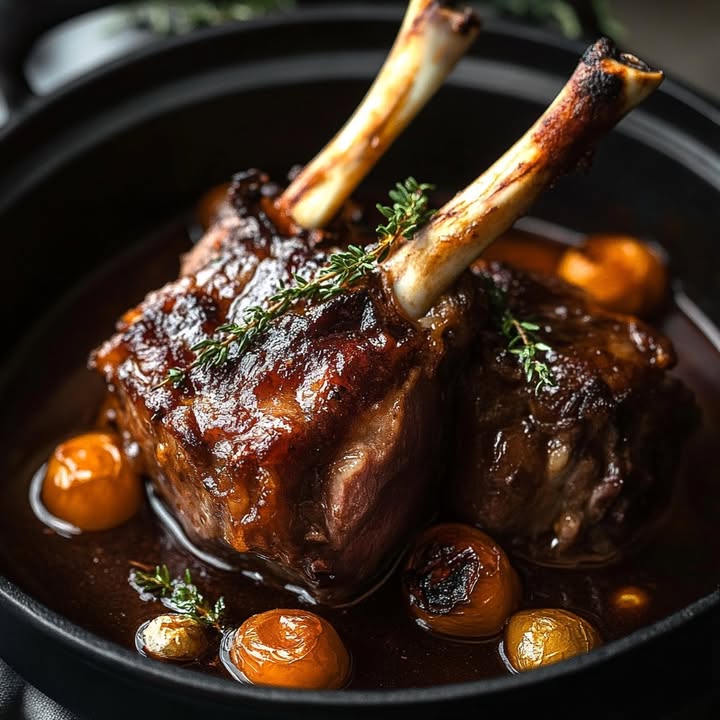
Slow-Cooked Lamb: A Comfort Food Masterpiece
There’s something magical about the smell of herbs and tender lamb filling your kitchen on a lazy Sunday afternoon. Last winter, I decided to try making Slow-Cooked Lamb for my family. My kids were skeptical at first—lamb isn’t exactly their go-to—but once they took their first bite, silence fell over the table. That’s when I knew this dish was a keeper. It’s rich, comforting, and perfect for anyone who loves melt-in-your-mouth meat with a fragrant, herby sauce.
The Roots of Slow-Cooked Lamb
This recipe has its roots in traditional French cuisine, where slow-cooking techniques transform tough cuts of meat into tender, flavorful masterpieces. Jarrets d’agneau (lamb shanks) are often braised in wine or broth and served as a centerpiece dish during festive meals. While this version skips the wine and uses a slow cooker, it retains all the authenticity and warmth of the original. When I tested it, I loved how hands-off the process was. Just prep, set, and forget—perfect for busy cooks!
Why You’ll Love This Recipe
This Slow-Cooked Lamb is everything you want in a comfort food dish. The lamb becomes so tender it practically falls off the bone, while the sauce is packed with earthy herbs like thyme and rosemary. Plus, it’s almost foolproof! Even if you’re new to cooking lamb, this recipe will guide you every step of the way. And let’s not forget—it’s incredibly versatile. Serve it with mashed potatoes, couscous, or crusty bread, and you’ve got a meal that feels both homey and gourmet.
Perfect Occasions to Prepare This Dish
This dish shines during cozy family dinners, holiday gatherings, or even date nights at home. It’s hearty enough to impress guests but simple enough for a weeknight treat. I love making it on chilly evenings when everyone craves something warm and satisfying. It’s also a great option for meal prep since the flavors deepen over time.
Ingredients
- 4 lamb shanks
- 1 tablespoon all-purpose flour, divided
- 3 tablespoons vegetable oil, divided
- 1 large onion, chopped
- 3 medium carrots, sliced
- 3 celery stalks, chopped
- 5 garlic cloves, minced
- 2 tablespoons tomato paste
- 500 ml lamb, beef, or chicken broth
- ½ teaspoon salt
- ½ teaspoon black pepper
- 1 teaspoon dried rosemary
- 1 teaspoon dried thyme
- 4 bay leaves
- 2 tablespoons cornstarch
- 1 teaspoon balsamic vinegar
- 1 teaspoon sugar (optional)
Substitution Options
If you can’t find lamb shanks, beef short ribs work beautifully. Swap the broth for vegetable stock to make it vegetarian-friendly (though you’ll need a plant-based protein). Fresh herbs can replace dried ones—just double the amount. For a gluten-free version, use rice flour instead of all-purpose flour.
Step 1: Seasoning the Meat
Start by seasoning your lamb shanks. In a small bowl, mix 1 tablespoon of flour with salt and pepper. Coat each shank evenly, shaking off any excess. This step ensures a beautiful crust forms when you sear the meat. Pro tip: Pat the lamb dry with paper towels before seasoning—it helps achieve that golden-brown color we all crave.
Step 2: Browning the Shanks
Heat 2 tablespoons of oil in a skillet over medium-high heat. Sear the lamb shanks on all sides until they develop a deep brown crust—about 10 minutes total. Don’t rush this step; browning adds incredible depth of flavor. Once done, transfer them to your slow cooker. The aroma alone will have your mouth watering!
Step 3: Preparing the Vegetables
Chop the onion, carrots, celery, and garlic. These veggies form the base of the sauce, lending sweetness and complexity. As you dice, imagine the layers of flavor they’ll bring to the dish. Nothing beats the earthy scent of fresh herbs mingling with caramelized onions.
Step 4: Sautéing the Veggies
In the same skillet, add the remaining oil and sauté the vegetables for 3 minutes. Stir in the tomato paste and leftover flour, coating everything evenly. This creates a thick, flavorful foundation for the sauce. Chef’s tip: Deglaze the pan with a splash of broth to scrape up those delicious browned bits—they’re pure gold!
Step 5: Building the Sauce
Pour in the broth, followed by rosemary, thyme, bay leaves, salt, and pepper. Let it simmer briefly before pouring it over the lamb in the slow cooker. The liquid should cover the shanks halfway, creating a steamy environment for slow cooking. Picture the lamb soaking up all those savory juices—it’s almost hypnotic.
Step 6: Slow Cooking
Cover and cook on HIGH for 4 hours or LOW for 8 hours. During this time, the lamb transforms from tough to buttery-soft. Trust me, patience pays off here. Peek occasionally to check progress, but resist the urge to lift the lid too often—it slows down cooking.
Step 7: Finishing Touches
Once cooked, remove the lamb and keep it warm. Strain the sauce into a pot and whisk in cornstarch mixed with cold water. Simmer until thickened, then stir in balsamic vinegar and sugar. Taste and adjust seasoning. Voilà—a glossy, herbaceous sauce ready to drizzle over your masterpiece.
Timing
Prep Time: 20 minutes
Cook Time: 4–8 hours
Total Time: 4 hours 20 minutes or 8 hours 20 minutes
Chef’s Secret
Add a splash of red wine to the broth for an extra layer of richness. It pairs beautifully with the herbs and enhances the overall depth of the dish.
Extra Info
Lamb is considered a “red meat” despite coming from young sheep. Its unique flavor comes from its higher fat content, which makes it ideal for slow-cooking methods like braising.
Necessary Equipment
You’ll need a slow cooker, a large skillet, a wooden spoon, a sharp knife, and a whisk. If you don’t own a slow cooker, a heavy-bottomed Dutch oven works just fine in the oven.
Storage
Store leftovers in an airtight container in the fridge for up to 3 days. The flavors continue to meld, making day-two servings even tastier. For longer storage, freeze portions in freezer-safe bags for up to 3 months.
Reheat gently on the stovetop or microwave, adding a splash of broth to loosen the sauce if needed. Avoid overheating, as it can dry out the lamb.
To refresh frozen portions, thaw overnight in the fridge, then reheat slowly. This method preserves the texture and flavor of the dish.
Tips and Advice
- Use fresh herbs whenever possible—they elevate the dish significantly.
- Don’t overcrowd the skillet when browning the lamb; work in batches if necessary.
- Let the lamb rest for 5 minutes after cooking to retain moisture.
Presentation Tips
- Garnish with fresh parsley or rosemary sprigs for a pop of color.
- Serve atop creamy mashed potatoes or alongside fluffy couscous.
- Drizzle the sauce artfully around the plate for restaurant-worthy flair.
Healthier Alternative Recipes
1. Herb-Crusted Lamb Chops: Skip the slow cooker and bake lean lamb chops coated in breadcrumbs and herbs.
2. Moroccan-Inspired Tagine: Use apricots, cinnamon, and chickpeas for a North African twist.
3. Grilled Lamb Kebabs: Marinate chunks of lamb in yogurt and spices, then grill for a lighter option.
4. Lentil and Lamb Stew: Add lentils to the slow cooker for extra fiber and protein.
5. Greek-Style Roast Lamb: Roast lamb with lemon, oregano, and potatoes.
6. Spiced Lamb Burgers: Mix ground lamb with cumin, coriander, and mint for juicy burgers.
Mistake 1: Skipping the Browning Step
Many people skip browning the lamb to save time, but this step is crucial for building flavor. Without it, the dish lacks depth and richness. Pro tip: Take the extra 10 minutes—it’s worth it!
Mistake 2: Overcooking the Vegetables
Overcooked veggies turn mushy and lose their vibrant taste. Sauté them just until softened, keeping them slightly firm for texture contrast.
Mistake 3: Using Too Much Liquid
Too much liquid dilutes the sauce and prevents the lamb from becoming tender. Stick to the recommended amount, adjusting only if needed.
FAQ
Can I use beef instead of lamb?
Absolutely! Beef short ribs or chuck roast work well in this recipe. Adjust cooking times slightly based on thickness.
What sides pair best with this dish?
Mashed potatoes, couscous, rice, or crusty bread complement the rich flavors perfectly.
Is this recipe gluten-free?
Yes, simply substitute the flour with a gluten-free alternative like rice flour.
Can I make this ahead?
Definitely! This dish tastes better the next day as the flavors meld together overnight.
How do I know when the lamb is done?
The lamb should be fork-tender and easily pull apart. If it resists, give it more time in the slow cooker.
Can I freeze leftovers?
Yes, freeze individual portions for up to 3 months. Reheat gently for best results.
Do I need a slow cooker?
No, you can use a Dutch oven in the oven set to 300°F (150°C) for similar results.
What herbs pair best with lamb?
Rosemary, thyme, oregano, and mint are classic choices that enhance lamb’s natural flavors.
Can I add wine to the recipe?
Yes, a splash of red wine adds complexity. Add it along with the broth for maximum impact.
How many servings does this recipe yield?
This recipe serves 4 people generously, with about 455 calories per serving.
Final Thoughts
There’s nothing quite like the satisfaction of serving a dish as comforting and flavorful as Slow-Cooked Lamb. Whether you’re feeding your family or hosting friends, this recipe promises to deliver warmth, aroma, and unforgettable taste. So grab your slow cooker, gather your ingredients, and get ready to create a meal that will leave everyone asking for seconds—and maybe even thirds!

Slow-Cooked Lamb
Ingredients
Equipment
Method
- Season lamb shanks with a mixture of flour, salt, and pepper.
- Heat 2 tablespoons of oil in a skillet and sear lamb shanks on all sides for about 10 minutes.
- Transfer seared lamb shanks to a slow cooker.
- Chop the onion, carrots, celery, and garlic.
- In the same skillet, add remaining oil and sauté vegetables for 3 minutes.
- Stir in tomato paste and leftover flour, then deglaze with broth.
- Pour in broth with rosemary, thyme, bay leaves, salt, and pepper, then pour over lamb.
- Cover and cook on HIGH for 4 hours or LOW for 8 hours.
- Once cooked, remove lamb and keep warm.
- Strain sauce into a pot, whisk in cornstarch mixed with cold water, and simmer until thickened.
- Stir in balsamic vinegar and sugar; adjust seasoning as needed.
Nutrition
Notes
Don’t skip the browning step of the lamb; it adds essential flavor.
Leftovers can be stored in the fridge for up to 3 days or frozen for up to 3 months.
Reheat gently, adding a splash of broth if the sauce needs loosening.
This dish pairs perfectly with mashed potatoes, couscous, or crusty bread.
